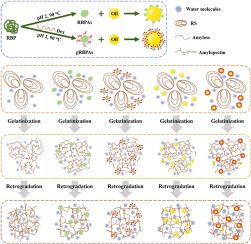Regulating effect of glycated rice bran protein aggregates and resultant emulsions on the gelatinization and retrogradation properties of rice starch
IF 11
1区 农林科学
Q1 CHEMISTRY, APPLIED
引用次数: 0
Abstract
The effects of the rice bran protein aggregates (RBPAs), glycated rice bran protein aggregates (gRBPAs) and resultant emulsions on the gelatinization and retrogradation characteristics of rice starch (RS) were investigated. The gelatinization and retrogradation properties of RS were determined by rapid viscosity analyzer (RVA), differential scanning calorimetry (DSC), dynamic rheology, X-ray diffraction (XRD) and scanning electron microscopy (SEM). The addition of the protein aggregates and the emulsions reduced the swelling of starch during the gelatinization process and the enthalpy change (ΔH) of RS. Meanwhile, during the long-term storage (4 °C for 21 d), the existence of the protein aggregates and the emulsions decreased the storage modulus (G′) and hardness of RS gel, thereby decelerating the retrogradation of RS. Besides, XRD analysis proved that when heated for 2 h, the relative crystallinity of the RS-gRBPAs mixture decreased by 6.08%, and the relative crystallinity of the corresponding RS-emulsions mixture reduced by 6.85%, which indicated the grafting of Dex could impede the retrogradation of RS. The inhibitory effect of adding the emulsions was more pronounced than that of adding corresponding protein aggregates. Furthermore, SEM analysis confirmed that the gel network structures of mixture were more uniform and compact compared with RS, which resulted from the protein aggregates and the emulsions inhibiting the internal combination through hydrogen bonds between starch molecules. Overall, these findings suggested that the protein aggregates and the emulsions prevented the retrogradation of RS, and could be potently used as a natural substitutes to enhance the quality and nutrition of starch-based foods.

糖化米糠蛋白聚合体及其产生的乳液对大米淀粉糊化和逆降解特性的调节作用
研究了米糠蛋白聚合体(RBPAs)、糖化米糠蛋白聚合体(gRBPAs)及其乳液对大米淀粉(RS)糊化和逆降解特性的影响。通过快速粘度分析仪(RVA)、差示扫描量热仪(DSC)、动态流变学、X 射线衍射(XRD)和扫描电子显微镜(SEM)测定了 RS 的糊化和逆降解特性。结果表明,蛋白质聚合体和乳液的加入降低了淀粉在糊化过程中的膨胀,也降低了 RS 的焓变 (ΔH)。同时,在长期储存(4 °C,21 d)过程中,蛋白质聚集体和乳液的存在降低了 RS 凝胶的储存模量(G′)和硬度,从而减缓了 RS 的逆降解。此外,XRD 分析表明,加热 2 小时后,RS-gRBPAs 混合物的相对结晶度降低了 6.08%,而相应的 RS-emulsions 混合物的相对结晶度降低了 6.85%,这表明 Dex 的接枝可以阻碍 RS 的逆降解。加入乳液的抑制作用比加入相应的蛋白质聚集体更为明显。此外,扫描电子显微镜分析证实,与 RS 相比,混合物的凝胶网络结构更均匀、更紧密,这是蛋白质聚集体和乳液通过淀粉分子间的氢键抑制内部结合的结果。总之,这些研究结果表明,蛋白质聚合体和乳液阻止了 RS 的逆变性,可作为天然替代品有效提高淀粉基食品的质量和营养。
本文章由计算机程序翻译,如有差异,请以英文原文为准。
求助全文
约1分钟内获得全文
求助全文
来源期刊

Food Hydrocolloids
工程技术-食品科技
CiteScore
19.90
自引率
14.00%
发文量
871
审稿时长
37 days
期刊介绍:
Food Hydrocolloids publishes original and innovative research focused on the characterization, functional properties, and applications of hydrocolloid materials used in food products. These hydrocolloids, defined as polysaccharides and proteins of commercial importance, are added to control aspects such as texture, stability, rheology, and sensory properties. The research's primary emphasis should be on the hydrocolloids themselves, with thorough descriptions of their source, nature, and physicochemical characteristics. Manuscripts are expected to clearly outline specific aims and objectives, include a fundamental discussion of research findings at the molecular level, and address the significance of the results. Studies on hydrocolloids in complex formulations should concentrate on their overall properties and mechanisms of action, while simple formulation development studies may not be considered for publication.
The main areas of interest are:
-Chemical and physicochemical characterisation
Thermal properties including glass transitions and conformational changes-
Rheological properties including viscosity, viscoelastic properties and gelation behaviour-
The influence on organoleptic properties-
Interfacial properties including stabilisation of dispersions, emulsions and foams-
Film forming properties with application to edible films and active packaging-
Encapsulation and controlled release of active compounds-
The influence on health including their role as dietary fibre-
Manipulation of hydrocolloid structure and functionality through chemical, biochemical and physical processes-
New hydrocolloids and hydrocolloid sources of commercial potential.
The Journal also publishes Review articles that provide an overview of the latest developments in topics of specific interest to researchers in this field of activity.
 求助内容:
求助内容: 应助结果提醒方式:
应助结果提醒方式:


